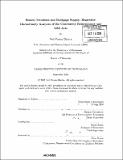| dc.contributor.advisor | Michael Greenstone and David Autor. | en_US |
| dc.contributor.author | Bhutta, Neil | en_US |
| dc.contributor.other | Massachusetts Institute of Technology. Dept. of Economics. | en_US |
| dc.date.accessioned | 2009-06-30T16:38:12Z | |
| dc.date.available | 2009-06-30T16:38:12Z | |
| dc.date.copyright | 2008 | en_US |
| dc.date.issued | 2008 | en_US |
| dc.identifier.uri | http://hdl.handle.net/1721.1/45920 | |
| dc.description | Thesis (Ph. D.)--Massachusetts Institute of Technology, Dept. of Economics, 2008. | en_US |
| dc.description | Includes bibliographical references. | en_US |
| dc.description.abstract | In this dissertation, I provide evidence of the causal impact on mortgage supply of the Community Reinvestment Act (CRA) and the "Government-Sponsored Enterprises (GSE) Act", laws requiring banks and the GSEs (Fannie Mae and Freddie Mac), respectively, to help improve credit access for low-income households and neighborhoods. While financial markets evolved rapidly since the early 1990's, I use discontinuities in the laws' eligibility rules to identify their effects. To implement the analyses, I use a census of mortgage applications collected under the Home Mortgage Disclosure Act. Overall, these programs appear to have had limited impact. I first analyze CRA's effect on mortgage lending in targeted neighborhoods: census tracts with a median family income (MFI) under 80% of MSA MFI. The regression discontinuity (RD) estimates suggest an overall credit supply shift of at least $6 billion ($2007) from 1994 and 2002 in targeted neighborhoods. In addition to CRA's direct effect on bank lending, I also find that unregulated institutions lend more in targeted tracts ("crowd-in"). Further analysis suggests that information spillovers from increased bank lending helps generate crowd-in. In Chapter 2, I examine CRA's effect on home purchase mortgage lending to households with income under 80% of the MSA MFI. In both Chapters 1 and 2, I find CRA's impact is concentrated in the largest MSAs, where enforcement is most intense. The RD estimates indicate that CRA caused a 6% increase in large MSA bank home purchase lending at the cutoff. | en_US |
| dc.description.abstract | (cont.) Unlike in Chapter 1, there is no theoretical basis for crowd-in and none is found. Nor do I find that banks crowd-out unregulated institutions. Finally, I measure the impact of one of the three goals established under the GSE Act. Under this goal the GSEs target census tracts with MFI under 90% of MSA MFI. The RD estimates suggest this goal led to a 3-4% increase in GSE purchases, and increased GSE-eligible originations by 2-3% at the cutoff. Unlike previous research, I find no evidence that the GSEs crowd-out FHA and subprime loans. The results imply a lower bound of the goal's impact of $2.4 billion between 1997 and 2002. | en_US |
| dc.format.extent | 99 p. | en_US |
| dc.language.iso | eng | en_US |
| dc.publisher | Massachusetts Institute of Technology | en_US |
| dc.rights | M.I.T. theses are protected by
copyright. They may be viewed from this source for any purpose, but
reproduction or distribution in any format is prohibited without written
permission. See provided URL for inquiries about permission. | en_US |
| dc.rights.uri | http://dspace.mit.edu/handle/1721.1/7582 | en_US |
| dc.subject | Economics. | en_US |
| dc.title | Federal mandates and mortgage supply : regression discontinuity analyses of the community reinvestment and GSE Acts. | en_US |
| dc.type | Thesis | en_US |
| dc.description.degree | Ph.D. | en_US |
| dc.contributor.department | Massachusetts Institute of Technology. Department of Economics | |
| dc.identifier.oclc | 320775640 | en_US |
